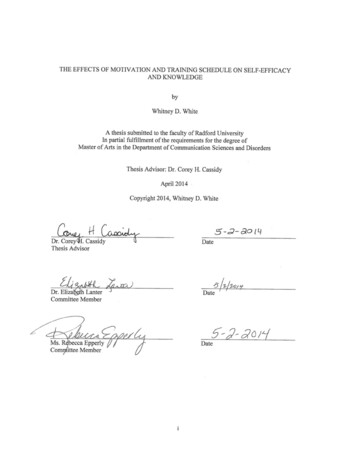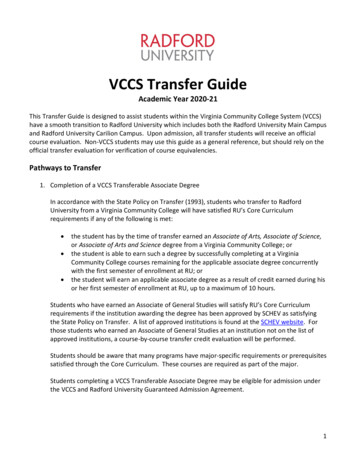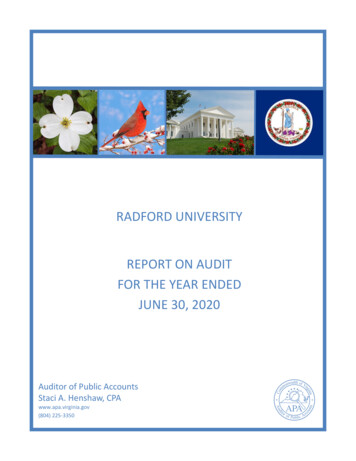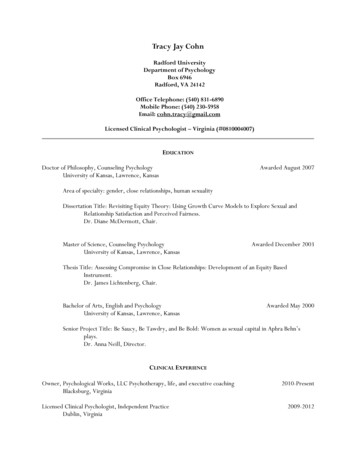
Transcription
i
AbstractIt is estimated that 15,000 children under the age of five are experiencing homelessnessin the Commonwealth of Virginia (Virginia Department of Education, 2011). Project Sprout (PS)is a prevention and awareness program designed to empower parents and families to help theirchildren develop and learn regardless of the environment in which they live. Graduate studentcoordinators recruit and train undergraduate and leveling students as PS advocates. Theadvocate’s role is to provide information, activities, and resources to families that target thedevelopment of early cognitive, language, literacy, and socio-emotional skills in children birth tofive years old. To teach these concepts, a ten-hour training program was developed by first-yearCommunication Sciences and Disorders graduate students. The training program was offeredtwice at separately scheduled times, referred to as the distributed schedule and the massedschedule. Once trained, advocates visit families in pairs to target child development.Evidence based research is lacking with regards to the efficacy of protocols andschedules needed to train undergraduate students specifically in the provision of prevention andawareness activities. To ensure quality and efficiency of the pilot PS Advocate Training Program(PS-ATP), the author investigated the effects of training schedule and type of motivation on levelof self-efficacy and change in knowledge. The author sought to answer the following questions:(a) did the PS-ATP lead to a change in knowledge, (b) was the change in knowledge different fordistributed versus massed schedules, (c) did the PS-ATP lead to a change in self-efficacy, (d)was the change in self-efficacy different for distributed versus massed schedules, and (e) wasintrinsic motivation associated with change in knowledge?The study included Radford University undergraduate and leveling students (n 16) fromfive departments with an average age of 21 years. A quasi-experimental design, with pre-postii
quantitative surveys, was used for this study. Data was obtained from quality control surveysembedded into the pilot PS-ATP.Undergraduate students who participated in the pilot PS-ATP demonstrated significantchanges in knowledge (t(15) -8.18, p .00, 2-tailed). Participants also demonstrated significantchanges in level of self-efficacy (t(15) -2.81, p .013, 2-tailed). Results of the study did notreveal significant differences in change in knowledge or level of self-efficacy betweendistributed and massed practice, supporting the claim made by Mumford et al. (1994) that manystudies have failed to demonstrate the distributed practice effect. Intrinsic motivation was foundto be positively associated with change in participant knowledge, extending previous findingsthat intrinsic motivation is predictive of greater progress and higher levels of mastery (Schunk &Zimmerman, 2008).Not only did the participants demonstrate a change in knowledge, the increase in selfefficacy validates that what they learned made them feel capable of becoming Project Sproutadvocates. The participants who identified as being intrinsically motivated at the outset of thestudy demonstrated greater changes in knowledge. This supports the existing literature whichsuggests that for service learning projects, intrinsic motivation leads to greater levels of progressand sustained volunteer engagement.Whitney D. White, B.B.A.Department of Communication Sciences and Disorders, 2014Radford Universityiii
AcknowledgementsThank you to my thesis committee, Dr. Corey H. Cassidy, Ms. Rebecca Epperly, and Dr.Elizabeth Lanter. Dr. Cassidy was kind enough to serve as my thesis advisor. She inspired me tostart this journey, and she never lost faith in me along the way. Mrs. Epperly and Dr. Lanter werekind enough to serve as my committee members. Mrs. Epperly provided a much needed criticaleye along the way and Dr. Lanter changed my perception about research. The three of theseprofessionals dedicated their time voluntarily and the only way I can repay them is by defendingmy research to the best of my ability. Finally I would like to thank my husband, Donald White,for his patience and understanding over the past two years.iv
Table of ContentsAbstract . iiAcknowledgements . ivTable of Contents . vList of Tables . ixTable of Figures . xIntroduction . 1Project Sprout: Helping Children Grow . 1The Role of Training Schedule in the Process of Learning . 2The Role of Motivation and Self-Efficacy in the Process of Learning. 4What Are the Effects of Motivation and Training Schedule on Self-Efficacy andKnowledge? . 5Chapter 1: Review of the Current Literature . 7Training Schedule: Distributed versus Massed. 7Theories of Distributed Practice Effect. 10Distributed Training Schedule and Knowledge Acquisition . 14Motivation . 15Theories of Motivation . 16Intrinsic Motivation . 18Extrinsic Motivation . 21Study of Motivation . 25Motivation to Volunteer. 26Motivation to Learn . 27v
Relationship Between Intrinsic Motivation and Knowledge Acquisition . 29Motivation for Service Learning . 31Relationships Between Motivation, Learning, Volunteering, and Service Learning. 33Self-Efficacy: General and Specific. 33Theory of Self-Efficacy . 35Sources of Self-Efficacy . 38Mediating Processes of Self-Efficacy . 40Self-efficacy and Knowledge . 43The Relationship Between Intrinsic Motivation, Self-Efficacy, and KnowledgeAcquisition . 44Training Schedule, Motivation, and Self-Efficacy: What is Responsible for Learning? . 45Chapter 2: Purpose of Study and Research Questions . 47Chapter 3: Method . 50Participants . 50Recruitment . 50Inclusion Criteria . 50Demographics . 51Consent . 51Data Collection Instruments . 52Procedures . 55Quality Assurance Surveys . 56Distributed Schedule Enrollment . 56vi
Massed Schedule Enrollment . 57Interstudy Interval and Retention Interval . 58Research Design. 59Data Analysis . 60Chapter 4: Results . 61Demographics . 61Data Analysis . 63Chapter 5: Discussion . 72Relationship Between Training Schedule and Change in Knowledge . 72Relationship Between Intrinsic Motivation and Change in Knowledge. 73Relationship Between Self-Efficacy and Change in Knowledge . 74Chapter 6: Limitations . 75Chapter 7: Implications . 77Relationship Between Training Schedule and Change in Knowledge . 77Relationship Between Self-Efficacy and Change in Knowledge . 78Relationship Between Intrinsic Motivation and Change in Knowledge. 78Conclusion . 80References . 81Appendix A: Terminology . 88Appendix B: IRB Approval Letter . 89Appendix C: Adult Informed Consent—Survey Research . 90Appendix D: Project Sprout Volunteer Survey . 92Appendix E: Intrinsic Motivation Survey . 94vii
Appendix F: Extrinsic Motivation Survey . 96Appendix G: Demographics Survey . 98Appendix H: Self-Efficacy Survey . 99Appendix I: Knowledge Acquisition Survey Module 1 . 100Appendix J: Knowledge Acquisition Survey Module 2 . 102Appendix K: Knowledge Acquisition Survey Module 3 . 104viii
List of TablesTable 1 - Type of motivation and outcomes across domains. 22Table 2 - Distributed schedule procedures. 58Table 3 - Interstudy and retention intervals of distributed schedule . 58Table 4 - Massed schedule procedures . 58Table 5 - Research Question #1 Test of Normality . 65Table 6 - Research Question #2 Test of Normality . 67Table 7 - Research Question #3 Test of Normality . 69Table 8 - Research Question #4 Test of Normality . 71Table 9 - Research Question #5 Test of Normality . 72ix
Table of FiguresFigure 1 - Cycle of behavior motivated by primary drives (Deci & Ryan, 1985) . 20Figure 2 - Cycle of behavior motivated by intrinsic needs (Deci & Ryan, 1985) . 20Figure 3 - Age of participants in training groups . 62Figure 4 - Gender of participants in training groups. 62Figure 5 - Race/Ethnicity of participants in training groups. 63Figure 6 - Class standing of participants in training groups . 63Figure 7 - Frequency distribution of pre-training Knowledge Acquisition Survey results . 65Figure 8 - Frequency distribution of post-training Knowledge Acquisition Survey results . 65Figure 9 - Frequency distribution of change in knowledge for distributed schedule . 66Figure 10 - Frequency distribution of change in knowledge for massed schedule . 66Figure 11 – Frequency distribution of average pre-training self-efficacy . 68Figure 12 – Frequency distribution of average post-training self-efficacy. 68Figure 13 - Change in self-efficacy for distributed schedule . 70Figure 14 - Change in self-efficacy for massed schedule . 70Figure 15 - Frequency distribution of pre-training average intrinsic motivation . 72x
IntroductionProject Sprout: Helping Children GrowAccording to the National Center on Family Homelessness (2003), two million peopleare dealing with homelessness in the United States at any given time. According to the VirginiaDepartment of Education, in the Commonwealth of Virginia alone, it is projected that over15,000 children under the age of five years are homeless (Virginia Department of Education,2011). The research suggests that homelessness can be a barrier to a child’s academic success;for example, in 2008 Walker-Dalhouse and Risko found that many children who experiencehomelessness are at risk for emotional, social, and behavioral problems that can later hinder theirschool attendance and performance. Early experiences with homelessness also tend to restrictchildren’s language and literacy development (Fantuzzo & Periman, 2007); 75 percent ofhomeless children in the United States end up performing below grade level in reading (Rubin etal., 1996).Not only does homelessness impact children’s development, research has also shownthat these experiences negatively impact parents’ perception of their ability to facilitate theirchild’s development (Swick, 2004). These parents often lack the knowledge, experience, andresources that are necessary to guide and support them when interacting with their own children(Bassuk et al., 2001).In light of this, there is an irrefutable need for prevention and awareness programs whosepurpose is to provide services to this population. Project Sprout is a prevention and awarenessprogram sponsored by Radford University and the Waldron College of Health and HumanServices that was designed for children between the ages of birth and five years with their1
families who are experiencing homelessness in the New River Valley of Virginia, including theCity of Radford and the counties of Montgomery and Pulaski.Project Sprout was developed to provide information, activities, and resources to familiesthat target the development of early cognitive, language, literacy, and socio-emotional skills inchildren birth to five years old. The goal of Project Sprout is to improve parents’ confidence andcompetence in helping to facilitate their child’s development, increase parents’ awareness andknowledge regarding development as it relates to their own children, and empower parents tohelp their children develop and learn regardless of the environment in which they live.In order to achieve the goals and objectives set forth by Project Sprout, RadfordUniversity undergraduate students enrolled in Communication Sciences and Disorders, Nursing,Psychology, Social Work, or Teacher Education & Leadership programs are trained by first yearCommunication Sciences and Disorders graduate students (Project Sprout student coordinators)to become advocates, go out into the community, and work with parents, helping them to engagein meaningful and positive interactions with their children. Advocates meet with families forone-hour visits in pairs. Project Sprout (PS) advocates are trained to model specific behaviorsthat target child development for the families with whom they work. Each family receives a bagthat includes materials for children between the ages of birth to five years. Materials include ageappropriate toys and books that target child development. Each bag also contains developmentalchecklists and resources for additional services. Families can keep the bags or follow up withProject Sprout and trade their bags in for new ones.The Role of Training Schedule in the Process of LearningIn March and April of 2013, the first annual PS advocate training program was conductedby the PS student coordinators. It was intended to develop skilled performance by Radford2
University undergraduate students in prevention and awareness activities designed to addressearly cognitive, language, literacy, and socio-emotional skills, and parents’ confidence andcompetence. A ten hour training program was developed by first-year Communication Sciencesand Disorders graduate students. The model of Parent, Family, and Community Engagement(PFCE) from the office of Head Start was used as a resource for training materials and activitiesgeared towards volunteer and parent/family collaboration (Head Start, 2014). Training materialswere also borrowed and adapted from the Women’s Resource Center of the New River Valley(WRC) Crisis Intervention Volunteer Training Program (WRC, 2013). The WRC providesextensive, interactive pre-service instruction which provides trainees with a wide variety oflearning experiences revolving around family and sexual violence, crisis intervention, andhelping skills.The training program was offered twice at separately scheduled times. The initialpresentation of the training program was broken into four 2.5- hour sessions, each of which tookplace on a weeknight over the course of two weeks. The second presentation of the trainingprogram consisted of one 10-hour session, which took place on a Saturday.The training program was designed to target four modules: (1) Introduction to PS, (2)Overview of Child Development, (3) Communicating with Parents, and (4) Putting it IntoPractice. Module 1 was designed to provide advocates with an introduction to Project Sprout andfamiliarize them with the structure of the program and their role within it. Module 2 wasdesigned to provide an overview of child development and review the importance ofunderstanding developmental milestones. Module 3 was used to teach effective collaborationwith parents, discuss what makes communication effective, and review skills necessary for3
working with the target demographic. Module 4 was used to provide advocates with anopportunity to practice what they had learned through role play and hands on experience.PS advocate training programs are scheduled to take place annually; subsequently, theneed for this study arose from a desire to document quality and efficiency of the pilot trainingprotocols to inform future training programs. In the future, only one training schedule will beoffered, and therefore the results of this study will be used to determine the training schedulewhich will be utilized in future PS advocate training programs.To document quality and efficiency, quality assurance measures in the form of surveyswere embedded into the spring 2013 pilot PS advocate training program. The content of the fourModules was used to assess the advocates’ change in knowledge through pre and post surveys.Current research suggests that memory and learning receive considerable advantages whenmaterial is presented in a distributed fashion (Benjamin & Tullis, 2010). The existing literatureon training schedule will be discussed, including how to differentiate distributed versus massedschedules, and which schedule is currently thought to have the most resounding effects onlearning, based on the available literature.The Role of Motivation and Self-Efficacy in the Process of LearningTraining schedule is a critical component of a quality training program; unfortunately, thescheduling of the training is not always the priority. Therefore, this study also seeks to shed lighton other sources from which learners draw in their attempt to master new skills, specifically typeof motivation and level of self-efficacy. Pre- and post-surveys were used to monitor theadvocates’ type of motivation and level of self-efficacy, as these constructs are known to predictstudent retention and achievement (Walker et al., 2006).4
Deci & Ryan (1985) suggest that motivation is the driving force behind an individual’schoice of activity, the effort with which they engage in activities, and the persistence with whichthey complete activities. In addition, an individual’s motivational disposition coupled with asupportive environment can result in multiple opportunities for mastering new skills andacquiring new knowledge (Ryan & Deci, 2008; Wentzel & Wigfield, 2009)Bandura (1993) describes self-efficacy as a belief in one’s capabilities, which regulateshuman functioning by influencing how individuals motivate themselves. By influencing ourchoices and motivational level, beliefs of self-efficacy make a significant contribution to theacquisition of knowledge structures on which skills are founded (Bandura, 1998); furthermore,the most compelling source of self-efficacy is an individual’s evaluation of their actualperformance in a given situation. These experiences provide individuals with the most authenticappraisal of whether or not they have what it takes to succeed (Bandura, 1998). The theoreticalframework of motivation and self-efficacy will further be explored in the literature review, alongwith a thorough description of how they contribute to the tasks of learning and volunteering.What Are the Effects of Motivation and Training Schedule on Self-Efficacy andKnowledge?The literature suggests that an individual’s motivational disposition is closely related toacademic achievement (Ames & Archer, 1988; Deci & Ryan, 2008; Nolen, 1988; Schunk &Zimmerman, 2008; Vallerand & Bissonnette, 1992; Wentzel & Wigfield, 2009). Qualityassurance pre- and post-surveys were used to determine if the advocates’ type of motivation wasassociated with their change in knowledge.According to the existing literature, there is no clear understanding as to which trainingschedule offers the greatest advantage to learning and memory (Cepeda et al. 2006; Donovan &5
Radosevich, 1999). Providing two training sessions allowed for between-group comparisonsregarding the effects of training schedule on self-efficacy and knowledge. Quality assurance preand post-surveys were designed to explore specific questions. The most salient question waswhether or not the pilot PS advocate training program succeeded as an effective intervention. Inother words, did the advocates experience a change in knowledge because they participated?This question was then elaborated upon to explore whether or not the training schedule couldaffect the participants’ change in knowledge; was there a greater benefit to participating in oneschedule versus the other? Likewise, the level of self-efficacy was measured within and betweengroups. If one training schedule seemed to result in greater changes in knowledge, was it thenlogical to assume that greater changes in level of self-efficacy would also be observed for thatsame schedule?6
Chapter 1: Review of the Current LiteratureThis study was designed to examine type of motivation (intrinsic/extrinsic) and type oftraining schedule (distributed/massed) as they relate to level of self-efficacy and change inknowledge of PS objectives, child development, and interpersonal communication skills. Areview of the author’s operational definitions of those variables is included in Appendix A. Thefollowing literature review closely examines the history and theoretical perspective of thevariables included in this study. Training schedule, motivation, and self-efficacy will be definedand considerations within each construct will be presented as they relate to knowledgeacquisition.Training Schedule: Distributed versus MassedThe relationship between instruction (training) schedule and retention of material haslong been examined (Cepeda et al., 2006; Donovan & Radosevich, 1999). Within the literature,instruction or training schedules have frequently been referred to as either distributed or massed(Baddeley et al. 1978; Cepeda et al. 2009; Donovan et al. 1999; Mumford et al. 1994; Seabrooket al. 2005). Currently, the practical application of either instructional schedule, be it distributedor massed, as it applies to classroom learning situations, is ill-documented (Cepeda et al. 2009).Although evidence suggests there is potential benefit to learning from distributed practice(Seabrook et al., 2005), discrepancies exist amongst schedules of distribution that are reported tohave optimal outcomes (Cepeda et al. 2009).In its early conception, distributed training simply referred to short training sessions(Baddeley, 1978). The operational definition has evolved over the years and now often refersspecifically to a schedule that requires subjects to study the same material in two learningepisodes separated by an interstudy gap (Cepeda et al., 2009). Similarly, massed training was7
initially viewed simply as longer sessions (Baddeley, 1978) but is now understood to refer tostudy time that is devoted to a given item and not subject to any interruptions of interveningitems or time (Cepeda et al., 2006).To qualify as a distributed training schedule, presentation of the same material must beseparated by either time or different material. The interval separating the study episodes of thesame material is known as the interstudy interval (Cepeda et al., 2006). Researchers have alsocompared different levels of spacing through increased temporal lags between study episodes orincreased items between two presentations of a repeated item (Seabrook et al., 2005; Cepeda etal., 2009). Comparison of different levels of spacing is known as the lag effect, whereas the termspacing effect is used to refer to the overall advantage of spaced compared to massed study onlearning (Cepeda et al., 2006). In order to measure the effects of distributed training schedules onlearning and memory, it is necessary to administer a final test once training has concluded. Thetime separating the final study episode and a later test is referred to as the retention interval(Cepeda et al., 2006). Research has shown that collectively, these factors lead to enhancedlearning; this finding is known as the distributed practice effect, which refers to the effect ofinterstudy interval upon learning as measured on subsequent tests (Cepeda et al., 2006).Massed training schedules refer to the concentrated teaching of a topic in a single session(Seabrook et al., 2005). To qualify as a massed training schedule, individuals must practice atask continuously without rest (Donovan & Radosevich, 1999). Re
The study included Radford University undergraduate and leveling students (n 16) from . program sponsored by Radford University and the Waldron College of Health and Human . Nursing, Psychology, Social Work, or Teacher Education & Leadership programs are trained by first year .










